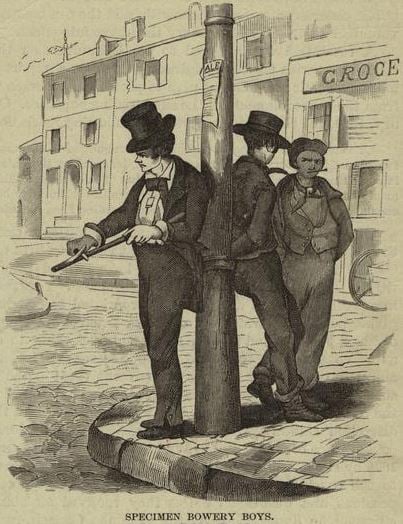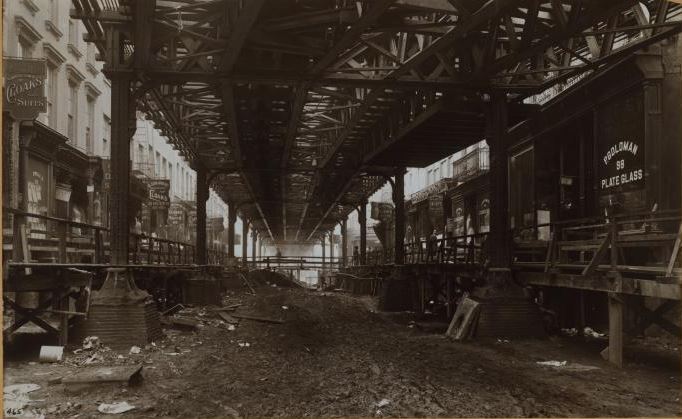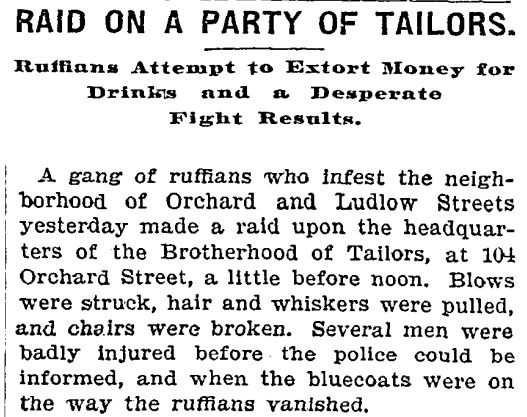Blog Archive
Crime on the Lower East Side

An illustration of a group of Bowery Boys, a street gang that terrorized the Lower East Side in the mid 19th century. Image courtesy the New York Public Library.
People often ask us if 97 Orchard Street was ever the scene of any crimes, and the answer is yes! We know of a few crimes committed here, including an 1894 report of “gambling” (sadly, there is no record of who was doing the gambling). But outside of the walls of 97 Orchard Street, the Lower East Side was a tough neighborhood; prostitution and gang activity was high.
Prostitution was a pervasive part of immigrant life on the Lower East Side. One street over, Allen Street stood as the neighborhood’s most notorious area for prostitution, most of which took place in tenements. One observer remarked that in “broad day light you can see [prostitutes] at their windows and calling to passers by at night. They are so vulgar in front of their houses that any respectable person cannot pass without being insulted by them.”

Allen Street at Division Street, undated. Prostitutes often frequented Allen Street because of the darkness that the above ground train provided. Image courtesy the New York Public Library.
Another resident lamented that neighborhood women could not walk the street after dark “without becoming a victim to the because of the paramours who hang around corners awaiting the proceeds of their concubines.” Little could be, or was chosen to be done about the problem as the very police who were supposed to curb the crime were often customers of the prostitutes.
Many local criminals stole handbags and lifted watches, but in the early 20th century violent crimes became more rare, especially in the predominantly Jewish tenth ward. “East Side Jews are the most peaceful people I have ever come in contact with,” observed James Reynolds of the University Settlement. Historian Jenna Weissman Joselit writes, “…on those occasions when Jews were indicted for murder, the Jewish community was simply astounded and found the association between Jews and violence to be ‘without precedent…in the whole course of Jewish history.’”
When violence did occur, it was often rooted in ethnic tension and conflict. Youth gangs frequently battled over territory in their respective parts of the Lower East Side. A Jewish gang known as the Black Hand would demand a tribute from residents, and if that tribute was not upheld, the gang would poison the horses of those they were extorting. An Italian gang also known as the Black Hand ruled Avenue D, robbing people at knifepoint.

The New York Times recounts a street gang who demanded extortion money from a group of tailors on 104 Orchard Street in 1897.
While prostitution, robbery and extortion, murder and rape, and gang violence played a role in the daily lives of Lower East Siders during the late 19th and early 20th centuries, residents were much less likely to come to harm than outsiders. Lower East Siders better understood the unwritten geography and social order of the neighborhood—which areas to steer clear of, which people to avoid.
Indeed, residents of the neighborhood during the 1920’s and 1930’s remembered a general feeling of safety when walking the streets at night. Knowing where not to venture and who not to cross no doubt mitigated residents’ likelihood of falling prey to crime and violence.
– Posted by David Favaloro, Director of Curatorial Affairs and Hebrew Technical Institute Research Fellow